Australian Retirement Trust Review: Comparative Analysis
Last Updated on 6 March 2024 by Ryan Oldnall
Australian Retirement Trust has grown to have 2.2 million members and $240 billion in assets under management as of April 2023, becoming one of Australia’s largest super funds [1].
In this Australian Retirement Trust Review, I will discuss Australian Retirement Trust performance, fees, and how it compares to the likes of Australian Super and Aware Super.
Who Are Australian Retirement Trust Super Fund?
Australian Retirement Trust Super was established in February 2022 following the merger of SunSuper and QSuper. This union brought together 2.2 million Super fund members, instantly creating one of the largest Super funds in Australia [1].
Australian Retirement Trust Super has continued to grow as it lines up a series of potential mergers.
In February 2023, Australian Retirement Trust Super entered into a Memorandum of Understanding (MoU) with AvSuper and Commonwealth Bank Group Super. Australian Retirement Trust has other mergers in the pipeline in addition to these two. [2] [3].
This aligns with Australian Retirement Trust’s broader strategy of pursuing mergers and aiming to manage assets worth $500 billion by 2030 [4].
The MoU with AvSuper is just one of the intended mergers Australian Retirement Trust has lined up. Australian Retirement Trust has also entered into a Memorandum of Understanding (MoU) with Alcoa of Australia Retirement Plan (Alcoa Super) [4].
How Big Is Australian Retirement Trust Super Fund?
According to Australian Retirement Trust, they currently have 2.2 members and counting as of May 2023 with $240 billion worth of assets under management [4].
For comparison, Aware Super had 1.1 million members and $125 billion under management as of May 2023 [5] and Australian Super had 3.06 million embers and $274 billion worth of assets under management [6].
In a comprehensive international study, worldwide pension funds were evaluated and ranked according to their size. Based on this global ranking, the Australian Retirement Trust Super Fund would be positioned approximately in 22nd place.
Notably, the study considered both QSuper and SunSuper, which, when combined, would have secured that 22nd position in the rankings [7].
For comparison, AustralianSuper Fund was found to be the 20th largest and Aware Super 46th in that same study [7].
Australian Retirement Trust Super Fund Is An Industry Super Fund
Industry superannuation funds, often known as profit-for-member funds, prioritize the well-being of their members as their main objective.
Australian Retirement Trust is an industry super fund that abides by the fundamental principle of not distributing dividends or profits since it lacks shareholders.
Instead, all generated funds are reinvested back into the fund, ultimately leading to the benefit of its members.
This approach mirrors the philosophy embraced by other industry super funds, including AustralianSuper and Aware Super
Australian Retirement Trust Review – Pre-Mixed Options
Growth Option
The Growth Option is an investment strategy designed to achieve robust long-term growth by diversifying its portfolio across a wide range of assets, with a specific focus on both Australian and international shares.
The current strategic allocations with the highest weighting for this option were 31.75% in Australian shares and 34.5% in international shares.
This allocation, indicates a strong emphasis on international exposure, demonstrating the desire to capitalize on global market opportunities alongside the domestic market.
The primary objective of the fund is to exceed the Consumer Price Index (CPI) by more than 4.5% per annum over the medium to longer term, accounting for account fees, costs, and taxes.
However, it’s important to note that due to the nature of high growth investments, there may be short-term fluctuations in returns.
Balanced Option
The Balanced Option is designed to achieve medium- to long-term growth while being mindful of the possibility of short-term fluctuations.
This option offers a diverse portfolio that includes investments in shares, fixed interest, property, and infrastructure
The current strategic allocations with the highest weighting for this option was 24% in Australian shares and 30% in international shares, 18.5% in fixed income, and 8.25% in property.
The primary objective of the balanced option is to outperform the Consumer Price Index (CPI) by more than 4% per annum over the medium to longer term.
It is important to consider that while the balanced investment option aims for growth, it acknowledges the potential for short-term fluctuations.
As a result, it is structured to provide stability and moderate risk while pursuing medium- to long-term growth.
Conservative Option
The conservative balanced investment option is designed to achieve medium-term growth while mitigating the volatility of returns through strategic investments in fixed interest and cash.
It employs a diversified approach by investing in various asset classes, combining active, enhanced index, and index investment management.
This option places a greater emphasis on fixed interest and cash allocations compared to the Balanced option, resulting in a more conservative investment approach. It allocates 7.5% to Australian shares,11.5% to international shares, 40% to fixed income, and 21% to cash.
The primary objective of the conservative balanced option is to surpass the Consumer Price Index (CPI) by more than 2% per annum over the medium term.
Although the conservative balanced option aims for growth, it acknowledges the significance of capital stability and may experience some short-term fluctuations.
The emphasis on fixed income and cash strategically contributes to providing stability to the portfolio.
Australian Retirement Trust Vs Australian Super Vs Aware Super
The performance histories of Australian Retirement Trust, Aware Super, and Australian Super are firmly established and can be compared.
Each of these Superannuation funds provides in-depth historical performance data, enabling us to evaluate and draw comparisons regarding their achievements over the past ten years.
In the course of these comparisons, the diagrams denote Aware Super as ‘AW,’ AustralianSuper as ‘AUS,’ and Australian Retirement Trust as ‘ART.’
The figures related to performance and fees are sourced from publicly available information on the respective Super funds’ websites as of June 2023.
Australian Retirement Trust Fund Performance Comparison
Australian Super vs Australian Retirement Trust and Aware Super Performance Over 10 Years
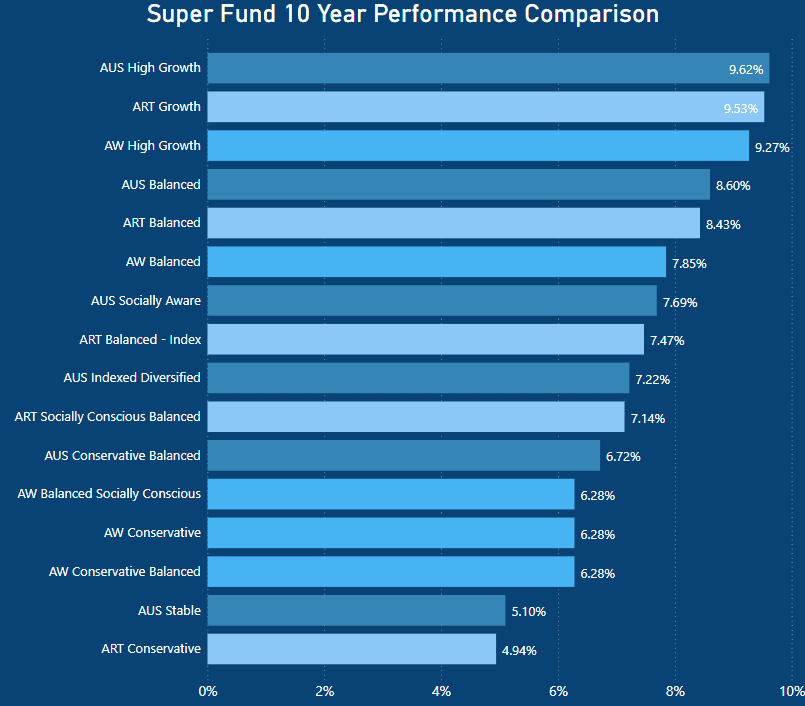
When we examine the performance of Australian Retirement Trust, AustralianSuper, and Aware Super over 10 years, it becomes evident that AustralianSuper’s high growth option emerges as the victor.
With a remarkable return of 9.62%, AustralianSuper’s high growth option marginally beats out Australian Retirement Trust. Aware Super’s high growth option was the lowest achieving 9.27%.
Across the board the different options had somewhat similar performances over the year 10 year period
Australian Retirement Trust High Growth and Growth Options Comparison
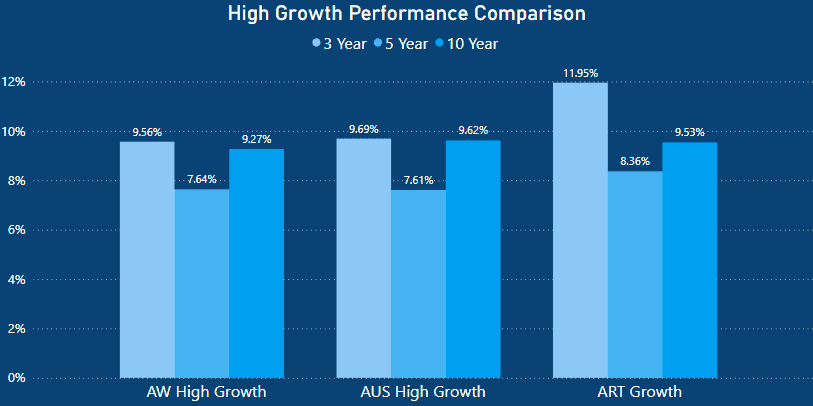
When examining the High Growth and Growth choices, Australian Retirement Trust stands out as the evident victor in the immediate span of 3 years, showcasing an impressive yield of 11.95%. This outcome surpasses Australian Super by a notable 1.99% margin and Aware Super by 2.39%.
In the medium term evaluation, Australian Retirement Trust continues to shine as the stronger contender, yielding a return of 8.36%.
This contrasts favorably with the comparable achievements of Aware Super and Australian Super, which reported returns of 7.64% and 7.61% respectively.
Across the extended horizon of 10 years, Australian Super demonstrates the best performance with a return of 9.62%. This surpasses Aware Super’s 9.27% and ART’s 9.53%.
Australian Retirement Trust Balanced Growth Options Comparison
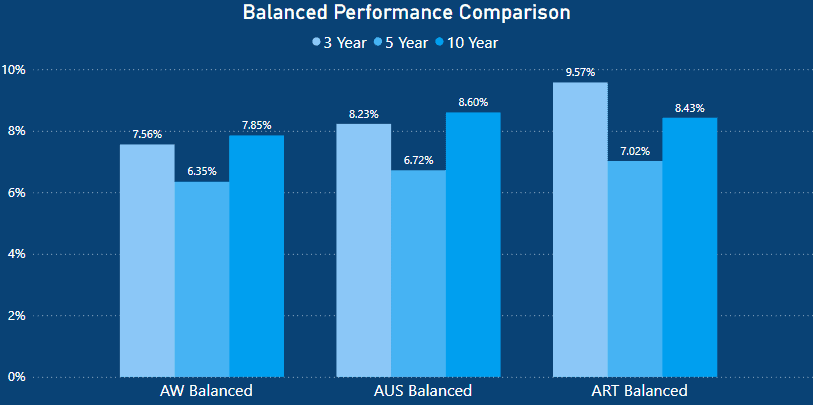
When analyzing the performance of the balanced options across the three super funds over a short-term 3-year period, Australian Retirement Trust emerges as the evident frontrunner, achieving an impressive return of 9.57%.
In contrast, Aware Super posted a significantly lower return of 7.56% during the same timeframe.
Extending the assessment to a 5-year period, Australian Retirement Trust maintained its superior performance. It generated a return of 7.02%, while Aware Super yielded 6.35%, and Australian Super achieved 6.72%.
However, delving into the 10-year performance records, Australian Super exhibited the most remarkable performance, surpassing both Australian Retirement Trust and Aware Super.
Australian Super’s return stood at 8.60%, which was 0.17% higher than that of Australian Retirement Trust and 0.75% greater than Aware Super’s.
Australian Retirement Trust Conservative and Stable Options Comparison
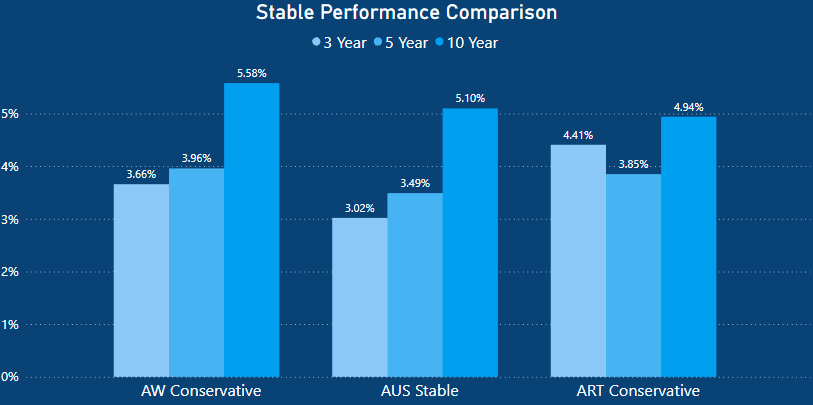
When examining a 3-year timeframe, Australian Retirement Trust consistently displays remarkable performance. Their conservative option delivered a notable return of 4.41%, whereas Australian Super recorded the least favorable return of 3.02%.
Transitioning to evaluations of medium-term achievements, the disparities are moderately comparable, with Aware Super attaining the highest performance at 3.96%, and Australian Super once again yielding the lowest return of 3.49%.
Over the extended span of 10 years, Aware Super emerges as the unequivocal leader in performance, boasting an impressive 5.58%. Following this is Australian Retirement Trust with 3.85%, and Australian Super with 3.49%.
Brief Explanation of Super Fees
Super funds charge different types of fees to cover various expenses related to managing your super account and investments. Here’s a breakdown of these fees:n
Administration Fees: These fees are imposed to cover the costs of managing your super account, including operating the call center and providing annual statements.
They can be a fixed amount, a percentage of your account balance, or a combination of both, usually with a maximum limit per year.
Investment Fees: Investment fees encompass both direct and indirect expenses related to investments.
This includes internal investment management costs, fees paid to third-party managers, custody expenses, derivative costs, and audit and administrative fees related to managing investments.
These fees contribute to the overall expenses incurred through investment activities.
Transaction Fees: Transaction costs are additional expenses borne by members who invest in specific options.
These costs include various expenses related to buying or selling underlying investments, such as brokerage fees, settlement and clearing costs, stamp duty on investment transactions, and due diligence expenses.
They also cover fees associated with individual members’ contributions, withdrawals, and switches between investment options.
Transaction costs are typically calculated based on estimated expenses for a specific period, like the year ending on June 30, 2023, and are expressed as a ratio relative to the average value of all assets in the investment option during that period.
It’s important to note that transaction costs can vary and may change from year to year.
Performance Fees: Performance fees are an additional cost beyond the regular investment and administration fees.
However, certain third-party investment managers may receive performance fees if they achieve returns that exceed a specified benchmark.
Australian Retirement Trust Fee Comparison: Investment Related Fee %
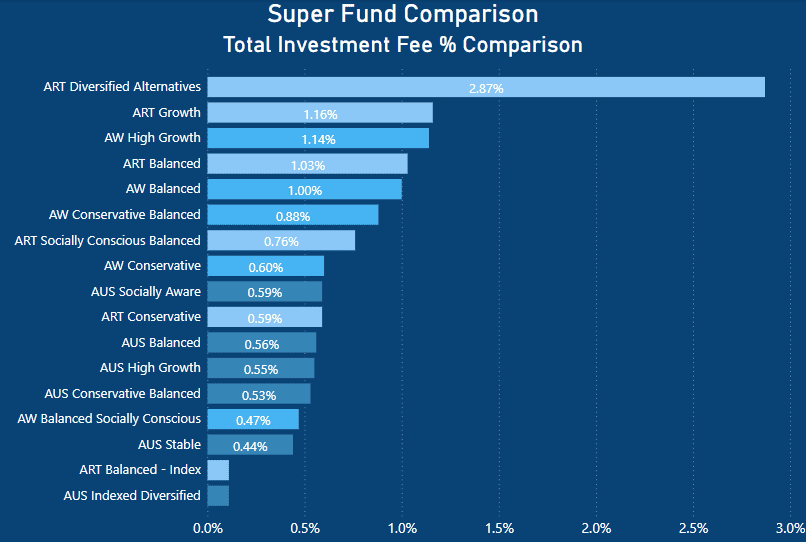
When analyzing investment-related fees, it becomes evident that the fee structures differ significantly depending on the specific super fund option.
Notably, Australian Retirement Trust’s diversified alternatives option stands out as the most expensive, charging a whopping 2.87%!
Comparing Australian Retirement Trust and Aware Super, their investment-related fee percentages are comparable across their options. The costs for their High Growth, Balanced, and Conservative options are considerably higher than those of Australian Super.
For Australian Super’s High Growth option, the investment-related cost is 0.55%, while the comparable products for Australian Retirement Trust and Aware Super are 1.16% and 1.14% respectively.
Australian Retirement Trust Fee Comparison: Administration Related Fee %
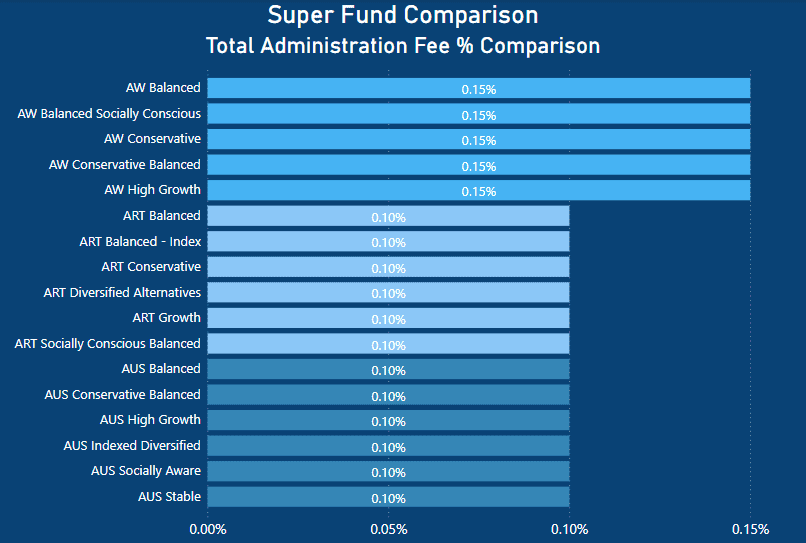
Upon analyzing the administration fee percentages, it becomes apparent that Aware Super has the highest rate at 0.15%, while both Australian Super and Australian Retirement Trust charge 0.10%.
In addition to the administrative fee percentages mentioned earlier, both AustralianSuper and Aware Super charge an additional weekly fee of $1.00. On the other hand, Australian Retirement Trust charges a slightly higher additional weekly fee of $1.20.
Australian Retirement Trust Fee Comparison: Total Fee %
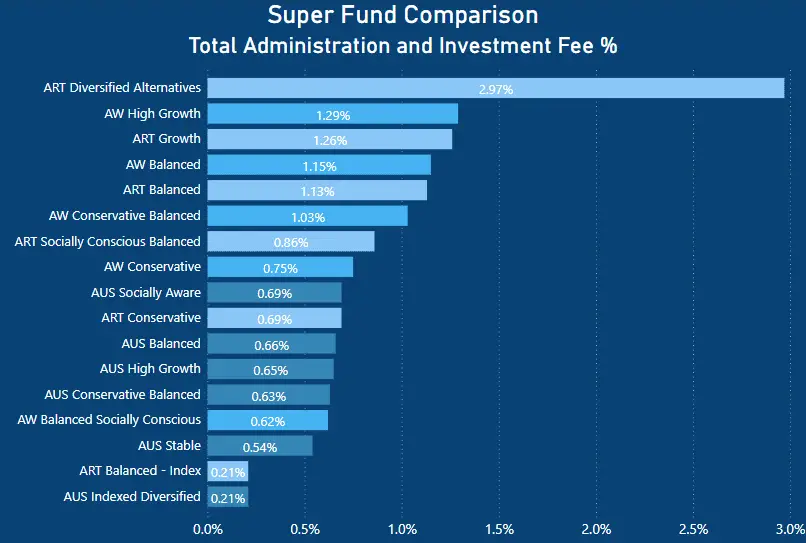
When comparing fees, unsurprisingly, Australian Retirement Trust’s diversified alternatives charge the highest at 2.97%. This is well over twice the amount of the second-highest option.
Both Australian Retirement Trust and Aware Super’s balanced and growth options are comparably priced. Australian Retirement Trust Growth option comes in at 1.26%, while Aware Super’s is 1.29%.
Similarly, Australian Retirement Trust’s balanced option is 1.13%, and Aware Super’s is 1.15%. When factoring in Australian Super’s options, their high growth and balanced choices are much cheaper.
Australian Super’s high growth option is 0.65%, and 0.66% for their balanced option. This is nearly half the percentage fees on both options.
It is essential to note that this chart displays fee percentages and does not include fixed dollar amounts charged by each fund.
Aware Super and Australian Super charge an additional $1 per week, whilst Australian Retirement Trust charges $1.20 in addition to the listed fee percentages.
Top 5 – Total Fee Related Percentages for High Growth, Growth, and Balanced Options
- AustralianSuper High, Growth – 0.65%
- AustralianSuper Balanced – 0.66%
- Australian Retirement Trust Balanced – 1.13%
- Aware Super Balanced – 1.15%
- Australian Retirement Trust Growth – 1.26%
Next, let’s explore how these percentages translate into real dollar amounts for the average investor.
Australian Retirement Trust Fee Comparison: On a $50,000 Super Balance
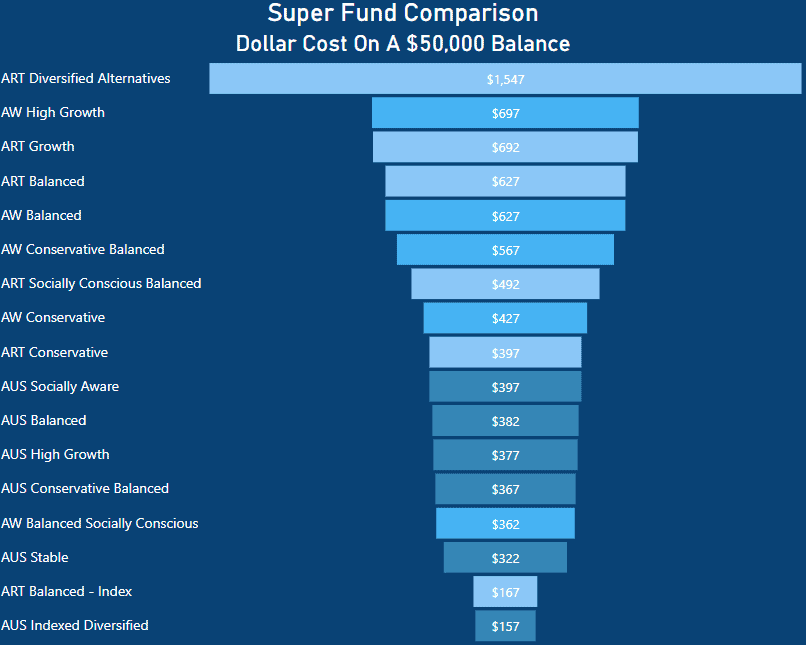
The actual costs of each Super Fund option reveal significant differences. For instance, on a balance of $50,000, Australian Retirement Trust’s diversified alternatives charge $1,547 annually in fees.
As expected, Australian Retirement Trust and Aware Super’s growth and balanced options are comparable. Australian Retirement Trust’s growth would cost $692 annually, while Aware Super’s high growth would cost $697.
Australian Retirement Trust’s and Aware Super’s balanced options are the exact same cost on a $50,000 balance at $627 annually.
When comparing this to Australian Super, the fees are very different. Australian Super charges $377 and $382 for their high growth and balanced option.
This means that annually, Australian Super’s high growth option is $315 cheaper than that of Australian Retirement Trust. Likewise, Australian Super’s balanced option is $245 cheaper than both Aware Super and Australian Retirement Trust.
The Top 5 Cheapest – High Growth, Growth, and Balance Options on a $50,000 Balance
- AustralianSuper High Growth -$377
- AustralianSuper Balanced – $388
- Australian Retirement Trust Balanced & Aware Super Balanced $692
- Australian Retirement Trust Growth – $692
- Aware Super High Growth – $697
Australian Retirement Trust Fee Comparison: On a $500,000 Super Balance
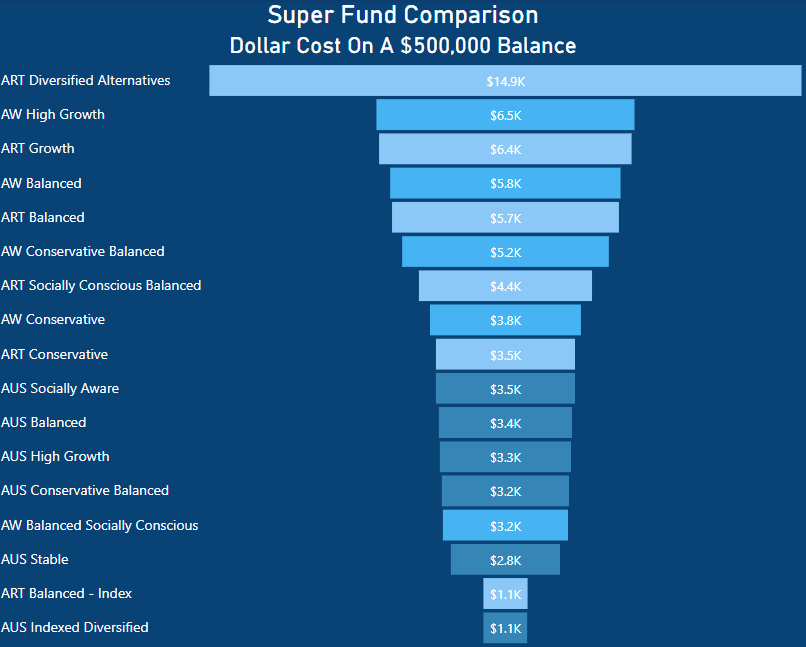
When considering a $500,000 balance, the discrepancies in fees become even more significant due to the percentage-based fees applied under each option.
For instance, on a balance of $500,000, Australian Retirement Trust’s diversified alternatives charge nearly $15,000 annually!
Due to Aware Super having slightly higher fee percentages than Australian Retirement Trust, their options start to increase in dollar cost.
For Aware Super’s High Growth option, would be $6,500 annually, while Australian Retirement Trust’s Growth option would be $6,360.
Australian Super would charge $3,300 annually for their high growth option, which is over $3,000 less than both Aware Super and Australian Retirement Trust.
The Top 5 Cheapest – High Growth, Growth, and Balance Options on a $500,000 Balance
- AustralianSuper High Growth -$3,300
- AustralianSuper Balanced – $3,350
- Australian Retirement Trust Balanced –$5,710
- Aware Super Balanced – $3,800
- Australian Retirement Trust Growth – $6,360
Australian Retirement Trust Insurance
The Australian Retirement Trust Super offers a variety of insurance options to select from within their products. The insurance cover provided by the fund includes three types:
- Total & Permanent Disablement (TPD) Cover: In the event of a permanent disability that leaves you unable to work, this option offers a lump sum payment.
- Death Cover: With Death Cover, you or your nominated beneficiaries will receive a lump sum payment in case of terminal illness or death.
- Income Protection: Income Protection ensures regular payments to replace a portion of your income if you are unable to work due to illness or injury. This coverage aims to maintain financial stability during challenging times.
Should You Switch to Australian Retirement Trust Super?
When contemplating a switch in super funds, it is essential to approach the decision thoughtfully and ensure that your reasoning and rationale are well-founded.
In my research on this topic, I have written an article about the process of How to Choose a Super Fund.
Australian Retirement Trust Super has demonstrated robust performance over time, comparable to peers like Australian Super.
Nonetheless, before considering switching super funds, there are several crucial factors to take into account:
Investment Performance: Carefully assess the investment performance of the super funds you are considering. Analyze their historical returns and compare them against industry benchmarks.
While past performance does not guarantee future results, it can offer insights into how the fund has fared under various market conditions.
Fees and Charges: Thoroughly evaluate the fees and charges associated with each super fund, including administration fees, investment management fees, and other costs.
Lower fees can significantly impact your long-term returns, making it essential to understand the fee structure of the fund you are contemplating.
Investment Options: Examine the variety of investment options offered within each super fund. Look for funds with a diverse range of options that align with your risk tolerance and investment objectives.
Insurance Coverage: Check if the super fund provides insurance coverage, including life insurance, total and permanent disability (TPD) insurance, and income protection insurance. Evaluate the cost and extent of coverage to ensure it meets your needs.
Additional Features and Benefits: Explore supplementary features offered by the super funds, such as online account management tools, educational resources, financial planning services, and member discounts. Consider which features align with your financial objectives.
Fund Stability and Reputation: Research the stability and reputation of the super funds under consideration. Examine their track record, financial strength, and member satisfaction ratings.
Factors like the fund’s size, longevity, and ability to consistently deliver returns over time should be considered.
Exit Fees and Insurance Implications: Before switching super funds, be aware of any exit fees or penalties associated with leaving your current fund.
Additionally, consider the impact on your insurance coverage during the transition period, as most insurance policies have a waiting period before becoming active.
Review the product disclosure statement (PDS) provided by the superannuation providers to gather specific information about insurance coverage and waiting periods.
By being aware of any exit fees or penalties and understanding the insurance implications, you can effectively evaluate the potential costs and consequences associated with switching super funds.
Conclusion: Switching To Australian Retirement Trust
Australian Retirement Trust Super has emerged as one of Australia’s largest super providers after its establishment in February 2022 through the merger of SunSuper and QSuper.
Setting ambitious goals, Australian Retirement Trust aims to grow its assets under management to $500 billion by 2030, more than double its current amount [4].
With several mergers in the pipeline, Australian Retirement Trust has the potential to keep pace with or even surpass AustralianSuper in the future.
Currently, AustralianSuper holds the position as the largest in terms of assets under management and membership numbers.
Although the size of the super funds is comparable, their fees are not. Australian Retirement Trust is more expensive than AustralianSuper.
When comparing their fees side by side, Australian Retirement Trust’s growth option on a $50,000 balance costs $315 more than AustralianSuper. Additionally, Australian Retirement Trust’s growth option returned 9.53%, which is comprable to Australian Super’s 9.62%.
So this begs the question, are Australian Retirement Trust’s higher percentage based fees justified?
When looking for low fee super funds, the Australian Super industry has welcomed a significant player in Vanguard. Vanguard is one of the world’s largest investment management companies with an impressive portfolio of assets worth over $11 trillion AUD worldwide [8].
In my Vanguard Super Review, I observed that, at the time, they were highly competitive with the likes of Australian Super. However, Vanguard Super was only launched in October 2022, so its long-term performance is yet to be measured.
Vanguard was observed to have excellent fees, which were lower than those of Australian Super at the time.
Similarly, in my Australian Super Review and Aware Super Review, I observed that Australian Super had some superior performances with some of the lowest fees when compared to funds of similar sizes.
So with this in mind, what does it mean for Australian Retirement Trust? With increased competition from the likes of Vanguard and low-fee alter funds like UniSuper, ART Super members will hope to enjoy more competitive fees in the future.
This article is for informational purposes only and does not constitute as an endorsement or recommendation to purchase any specific mentioned product. Past performance is not a reliable indicator of future performance.
- https://www.australianretirementtrust.com.au/merger/faqs
- https://www.australianretirementtrust.com.au/newsroom/australian-retirement-trust-and-avsuper
- ,https://qsuper.qld.gov.au/news-hub/articles/2023/02/28/00/39/commonwealth-bank-group-super-pursuing-a-merger-with-us
- https://www.australianretirementtrust.com.au/newsroom/art-continues-growth-trajectory-with-merger-announcement
- https://www.australiansuper.com/campaigns/super-moments
- https://www.australiansuper.com/careers/our-teams
- https://www.thinkingaheadinstitute.org/content/uploads/2022/09/PI-300-2022.pdf
- https://www.vanguard.com.au/adviser/en/aboutvanguard/about-us-tab







